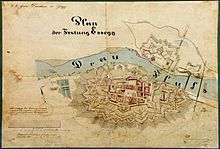
Back Traza italiana AST Ulduz formalı qala Azerbaijani Бастыённая сістэма ўмацаванняў Byelorussian Звездообразен форт Bulgarian Traça italiana Catalan Bastionová pevnost Czech Traza italiana Spanish Bastionijärjestelmä Finnish Fortification bastionnée French Dún réaltchruthach Irish





| Part of a series on |
| War Outline |
|---|
 |
A bastion fort or trace italienne (a phrase derived from non-standard French, literally meaning 'Italian outline') is a fortification in a style that evolved during the early modern period of gunpowder when the cannon came to dominate the battlefield. It was first seen in the mid-fifteenth century in Italy. Some types, especially when combined with ravelins and other outworks, resembled the related star fort of the same era.
The design of the fort is normally a polygon with bastions at the corners of the walls. These outcroppings eliminated protected blind spots, called "dead zones", and allowed fire along the curtain wall from positions protected from direct fire. Many bastion forts also feature cavaliers, which are raised secondary structures based entirely inside the primary structure.
- ^ Centre, UNESCO World Heritage. "The city of Bergamo - UNESCO World Heritage Centre". whc.unesco.org. Retrieved 2 November 2017.
© MMXXIII Rich X Search. We shall prevail. All rights reserved. Rich X Search